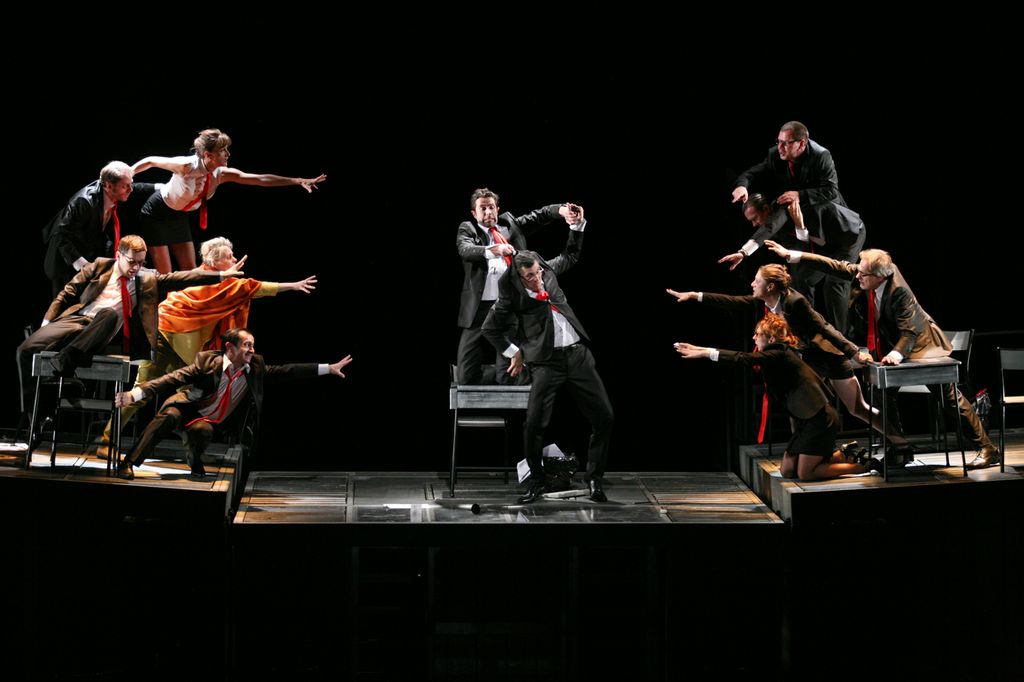I laughed quite a bit going round the exhibition to which the Barbican’s latest theatre events are tied, The Bride and the Bachelors. Pioneer Marcel Duchamp’s 1921 “Readymade” Why Not Sneeze, Rrose Sélavy? is funny in itself: a metal birdcage containing marble sugarcubes with a cuttle bone and a thermometer stuck through the bars. It’s even funnier when you learn that admirer Robert Rauschenberg, about to pinch a couple of cubes on a visit to the Philadelphia Museum of Art in the late 1950s, was told by the guard, “Don’t you know you’re not supposed to touch that crap?”
I laughed a lot, too, reading Eugène Ionesco’s Rhinocéros. I laughed rather less at a production which sometimes squashes the Romanian’s absurdist black humour under elegant French feet. But the Théâtre de la Ville-Paris’s clockwork precision and sure sense of pace do take us to the dark heart of a great play.
Elaborate mobile sets by Yves Collet are artworks in themselvesThe Parisians continue to keep Ionesco in the forefront of the dramatic repertoire while London theatre merely defers to his example in the abstract. Our long runner is The Mousetrap; Paris's is a double bill of Ionesco’s The Bald Primadonna and The Lesson, still to be seen at the tiny Théâtre de la Huchette 61 years after their first performances there.
Théâtre de la Ville parades its Ionesco on a bigger scale with an ensemble of 13 and elaborate mobile sets by Yves Collet which are artworks in themselves – but all in the cause of illuminating Emmanuel Demarcy-Mota’s initially fast-moving production which keeps the fable of Rhinocéros simple yet ambiguous. For Ionesco it was about the rise of Fascism, but as the pachydermal herd lacks a leader, it remains topical – a comic-serious riff on joining the pack, the latest fashion, the current opinion
That it’s the story of one man against a world bent on becoming beasts is made clear immediately by transposing a chunk of monologue for the protagonist, Bérenger, to the beginning of the play, before proper curtain up. He’s played with shabby gentleness by Serge Maggiani, following in the footsteps of Jean-Louis Barrault who created the role in 1960: part Molière outsider-hero, part Shakespearean soothsayer-clown (Demarcy-Mota and artistic collaborator François Regnault make this clear in a programme of enlightening articles, and they certainly practise what they preach). The provincial world in which Bérenger finds himself at odds would be funnier if it were less stylised, more realistic; the absurd breakthrough of an offstage rhino charge would have more of an impact too in the midst of the silly-mundane, but the direction and Jefferson Lembeye’s soundscape are intent on doomy portent. The mass activities of the second act’s office group aren’t terribly amusing either - collective typing on desks apart - until a worker turned rhino breaks down a staircase and the set slides, or rather elevates, into stylised chaos (pictured above).
The provincial world in which Bérenger finds himself at odds would be funnier if it were less stylised, more realistic; the absurd breakthrough of an offstage rhino charge would have more of an impact too in the midst of the silly-mundane, but the direction and Jefferson Lembeye’s soundscape are intent on doomy portent. The mass activities of the second act’s office group aren’t terribly amusing either - collective typing on desks apart - until a worker turned rhino breaks down a staircase and the set slides, or rather elevates, into stylised chaos (pictured above).
As Ionesco’s Theatre of the Absurd turns slowly to tragicomedy, the power of the individual acting beyond the crisp ensemble work asserts itself. Hugues Quester as Bérenger’s bullying friend Jean, a man seen on the edge from the start, convinces us he’s leathering up and turning green before our very eyes. Does the show deliver on Ionesco’s demand for “a lot of rhinoceros heads”? Available images don’t give the game away, so neither shall I; but suffice it to say that the last of the three acts, which run here compellingly without an interval, offers the most painterly visual coup. It’s a love scene with a very unValentineish conclusion between wounded Bérenger and secretary Daisy (Valérie Dashwood) played out in the near-dark. The Barbican Theatre’s black box fits this production as well as the gallery does the superb exhibition; go see them both, but be quick about it if you want to catch this Rhinocéros.















Add comment